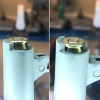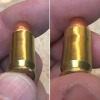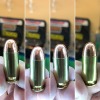Nature Boy
Member
- Joined
- Apr 21, 2015
- Messages
- 8,248
I was able to dramaticly reduce the jams by increasing the OAL to 1.250” using the Berry’s 230g RN.
Now I’m trying to fine tune my process
I’m still having issues with ~15% not passing plunk and case gage.

Plunk test pass/fail with the same case oriented 180 deg. which leads me to belive the bullet is getting cocked during seating

You can kind of see it here, looks like it bulging the case on one side.

I’m loading on a Dillon 650 using Dillon dies.

What do you guys think? What should I try to get my reject rate down?
Now I’m trying to fine tune my process
I’m still having issues with ~15% not passing plunk and case gage.

Plunk test pass/fail with the same case oriented 180 deg. which leads me to belive the bullet is getting cocked during seating

You can kind of see it here, looks like it bulging the case on one side.

I’m loading on a Dillon 650 using Dillon dies.

What do you guys think? What should I try to get my reject rate down?






